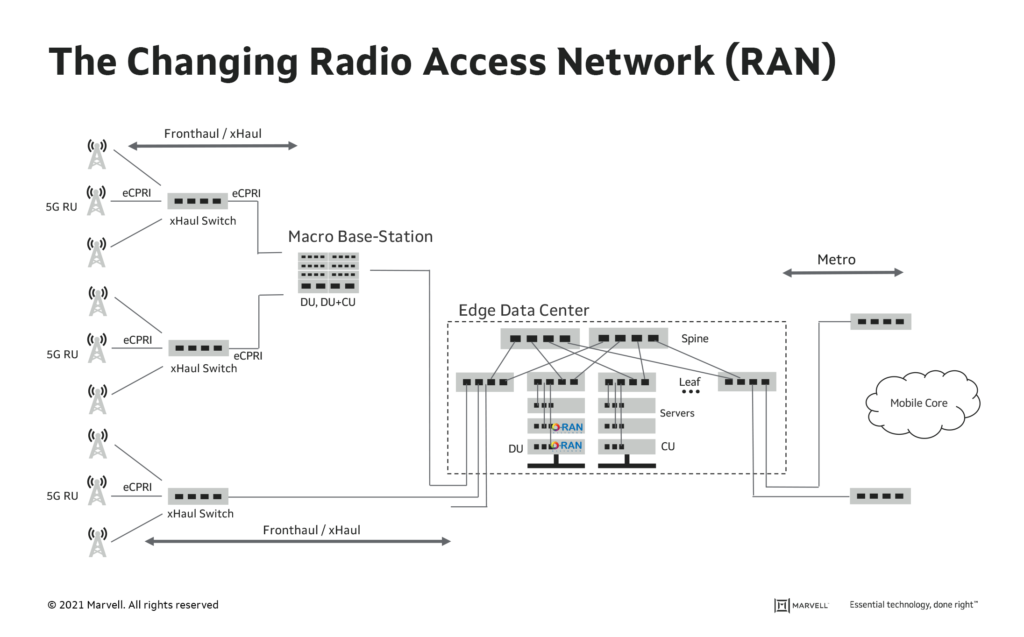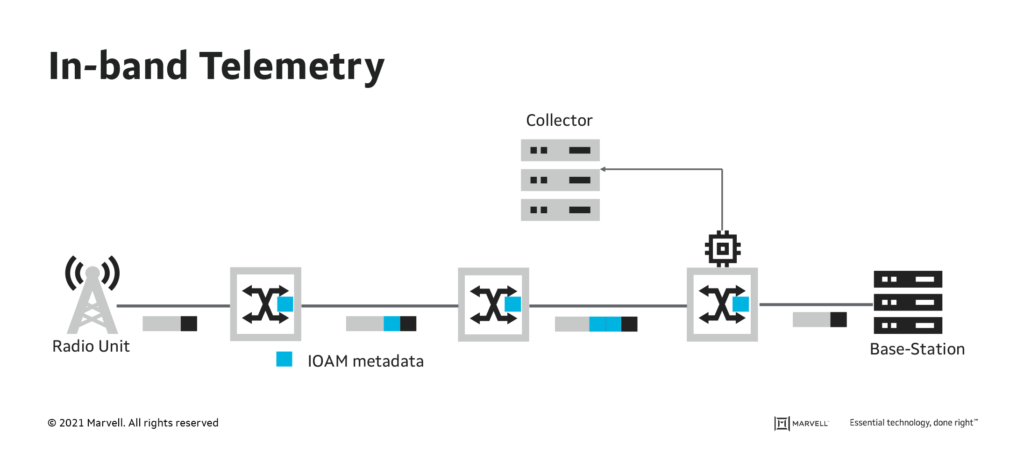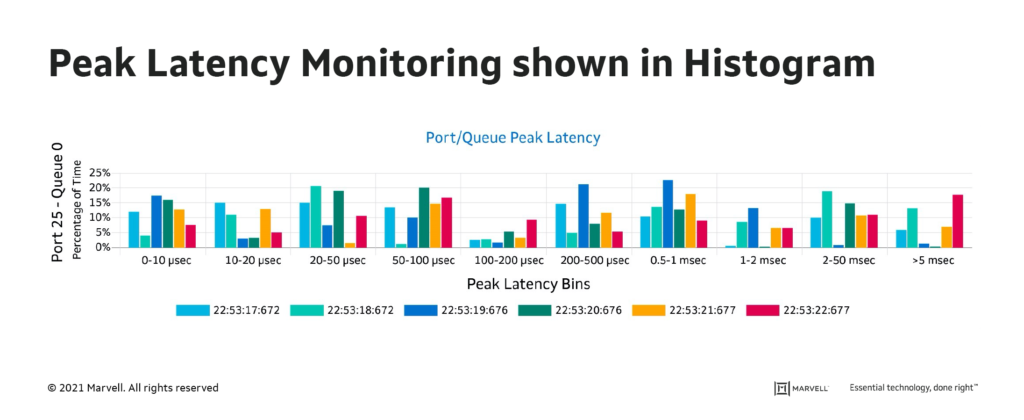- PRODUCTS
- COMPANY
- SUPPORT
- PRODUCTS
- BY TYPE
- BY MARKET
- COMPANY
- SUPPORT
Network Visibility of 5G Radio Access Networks, Part 1
The Radio Access Network (RAN) is dramatically changing with the introduction of 5G networks and this, in turn, is driving home the importance of network visibility. Visibility tools are essential for mobile network operators to guarantee the smooth operation of the network and for providing mission-critical applications to their customers.
In this blog, we will demonstrate how Marvell’s Prestera® switches equipped with TrackIQ visibility tools are evolving to address the unique needs of such networks.
The changing RAN
The RAN is the portion of a mobile system that spans from the cell tower to the mobile core network. Until recently, it was built from vendor-developed interfaces like CPRI (Common Public Radio Interface) and typically delivered as an end-to-end system by one RAN vendor in each contiguous geographic area.
Lately, with the introduction of 5G services, the RAN is undergoing several changes as shown in Figure 1 below:
- In centralized RAN architectures (known as C-RAN), baseband processing resources, called distributed units (DUs), are pooled in a macro base station hub or far edge data center and dynamically shared with remote radio units (RUs).
- The segment between the RU and the DU, called fronthaul, has transformed from using an interface called CPRI to enhanced CPRI (eCPRI), which runs over standard Ethernet packets and sometimes over UDP/IP packets.
- The move to packet-based fronthaul segments created in some deployment scenarios a switched network that aggregated many RUs into just a few DUs, reducing the number of fiber links and the number of interfaces on the DU.
- In the context of Cloudification and Virtualization of the RAN, known as Cloud-RAN and vRAN, 5G software building blocks are provided over virtual machines (VMs) or containers, and on top of commodity servers equipped with O-RAN compliance accelerators or on cloud native solutions.
- Disaggregation between software and hardware, in which full solutions previously provided by a single 5G vendor (Ericsson, Huawei, Nokia, ZTE and Samsung) can now be provided by multiple players each specializing on one aspect of the solution.

Figure 1: The Changing RAN
The above trends have a direct impact on the management and visibility tools used by MSOs to run an efficient and reliable network and monetize their investment by providing new advanced services, such as ultra-reliable low latency communications (URLLC).
Monitoring latency and jitter
A key task that visibility tools are expected to monitor in the RAN is latency. There are several latency requirements for each segment of the RAN.
The typical one-way frame latency budget for fronthaul is around 75usec, out of which more than half can be taken by propagation delay over fiber. The max latency per node thus needs to be kept very low, and this can only be guaranteed if queuing delay is at a minimum, with only a few packets at max waiting for transmission.
It is not enough to periodically check the latency of this segment; it is crucial to continuously check the latency of all packets, and check for any gradual or sudden increase in latency.
On the other extreme, it makes no sense to overwhelm a collector with the latency of each and every packet, but instead provide intelligent statistics on the latency distribution on the minimum, average and peak latency (providing an indication on the jitter added by each node). It is also important to provide statistics on trend analysis to anticipate problems before they arise, as well as on anomaly alerts that may affect the performance of the mobile network.
End-to-end latency is not enough. To identify the factors contributing to the latency, operators need to track the per hop latency, and also the path packets traversed in the network, making sure routing and load balancing decisions are optimal. Tracking latency on a per-flow basis usually provides the best granularity operators can relate to. A specific flow carries one type of application, for example an eCPRI flow, that has a known latency target. Each flow traverses the network via one route, thus after identifying and verifying this path, what is left is monitoring the latency on each hop of this path.
Marvell’s per-flow visibility and telemetry tools are best suited to provide the above for the Radio Access Network. The tools utilize new technologies called In-band Telemetry (INT) or In-situ OAM (IOAM) shown in Figure 2. With these technologies, information about the path the packet traversed, and the time it spent in each node, is added to the user’s packets as additional metadata, until it reaches its final destination or until it reaches the last hop of its journey:
Figure 2: In-band Telemetry
The collector receives digested, per-flow information, and is able to present the nodes in the network the flow has traversed, with additional information on the minimum, average and peak latency at each of these nodes. (See Figure 3 below.) There are several methods to provide the per-flow information to the collector, including IP Flow Information Export (IPFIX) that has the ability to include this additional metadata.
This information is gathered from the last node in the path, without the need to collect information from multiple nodes, and without the need to attempt to correlate the information into a coherent view. Precision Time Protocol (PTP) implemented in the network can also provide an accurate wall-clock timestamp in the IOAM or INT packets, and provide valuable information on the propagation delay in the network.
A video demonstration of the flow-tracking capabilities based on IOAM can also be viewed here:

Figure 3: Flow-Tracking based on IOAM
Some mobile network operators prefer a passive monitoring technique, which continuously tracks the latency of all queues, without adding metadata to user packets or adding additional OAM packets to the network. Monitoring the latency of queues instead of the latency of all flows provides an aggregated view on the differentiated services provided by the operator and dramatically reduces the amount of monitored entities. This is critical for a nationwide mobile network with thousands of network elements.
Marvell’s queue latency monitoring approach further reduces the amount of data that reaches the centralized controller by continuously analyzing the data and placing the latency information into latency bins. Figure 4 below shows a histogram of the latency on a specific port & queue. The Y-axis is the percentage of time (inside a specific second) the queue latency was in each of the latency bins shown on the X-axis. This is a live graph, in which each color represents a specific second during the day. In this example, the last six seconds are shown.
Let’s examine the ‘red’ second (the one on the left of each latency bin): It shows that for 12% of this second, the queue latency was between 0-10usec, 15% of this second latency was between 10 and 20usec, and so on. Such data can be sent to an analytic server for anomaly detection, trend analysis, catastrophic event detection and more.
Figure 4: Peak Latency Monitoring shown in Histogram
Summary
In this first blog of a two-part series, we discussed the ways the Radio Access Network (RAN) is dramatically changing with the introduction of 5G networks. We showed two network visibility techniques to monitor latency and jitter of the mobile network: A per-flow technique based on in-band telemetry, and a per-queue technique which provides information on each of the differentiated services offered by the RAN.
In part two of the series, we’ll delve into resource monitoring, Open RAN monitoring, and further explain why Marvell’s TrackIQ visibility tools can ensure the smooth operation of the network for mobile operators.
Recent Posts
- Marvell Named to America’s Most Responsible Companies 2026 List
- 5 Times More Queries per Second: What CXL Compute Accelerators Can Do for AI
- Marvell Makes Inaugural 100 Best Companies in Southeast Asia List
- Marvell Earns “Fittest Firm” Title in Silicon Valley Turkey Trot for 10th Consecutive Year
- The Next Step for AI Storage: GPU-initiated and CPU-initiated Storage
Archives
Categories
- 5G (10)
- AI (45)
- Cloud (18)
- Coherent DSP (11)
- Company News (106)
- Custom Silicon Solutions (8)
- Data Center (68)
- Data Processing Units (21)
- Enterprise (24)
- ESG (10)
- Ethernet Adapters and Controllers (11)
- Ethernet PHYs (3)
- Ethernet Switching (41)
- Fibre Channel (10)
- Marvell Government Solutions (2)
- Networking (43)
- Optical Modules (19)
- Security (6)
- Server Connectivity (32)
- SSD Controllers (6)
- Storage (23)
- Storage Accelerators (4)
- What Makes Marvell (47)
Copyright © 2025 Marvell, All rights reserved.
- Terms of Use
- Privacy Policy
- Contact

